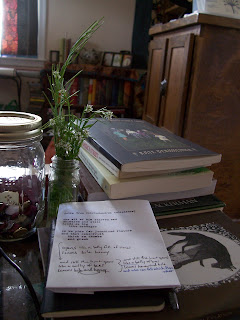Back to the typewriter again

I've let myself wallow in quite a dry spell the past few months. I guess I just had so many other projects I wanted to work on in my very limited free time and I sent writing back to the end of the line over and over again. It's time to push through that. Spring is here and a new year of writing begins now. Submissions have opened again for The Fairy Tale Review . This one will be The Yellow Issue and is to be guest-edited by Lily Hoang ! If you haven't read any of her work, do it now. The Evolutionary Revolution (from Les Figues Press) knocked the wind out of me. She also has a book published by Fairy Tale Review Press called Changing , which is on my nightstand now. I'll probably crack that open after I've finished The Complete Tales of Lucy Gold , by Kate Bernheimer (the last in the Gold sisters' trilogy). As a very minor side note which is completely off the point, the wildflowers (or, to some of you, weeds) in the picture above are called hairy bitte...


